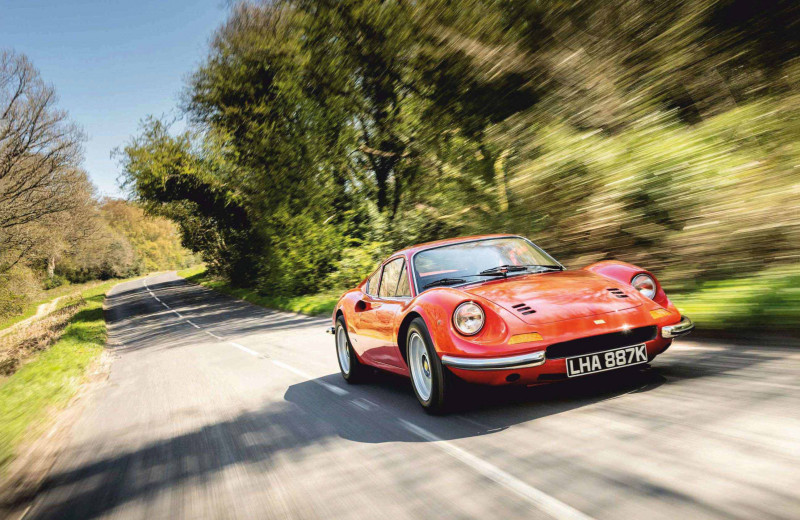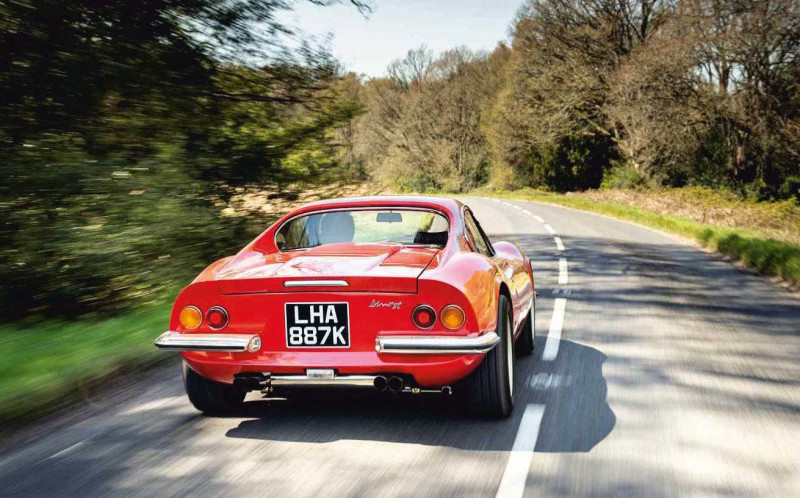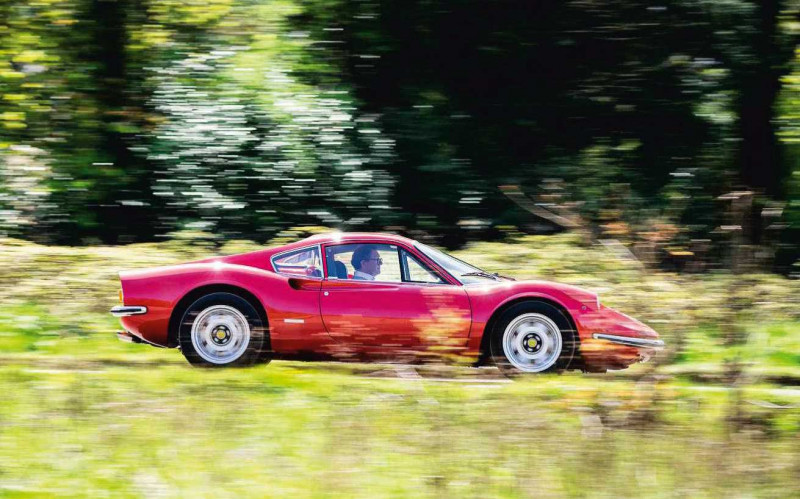1972 Dino 246 GT
Do you have to be a Jinancier to buy a derelict Dino and restore it as a daily driver? Well, yes as it turns out, but there are lessons for all of us here. Words James Elliott. Photography Paul Harmer, Louis Gargour, Autofficina.
DELIVERING THE DREAM
What it really takes to turn a Ferrari barnfind into a daily driver
Finding out the true cost of turning a wreck into a dream car
There are many universal truths in the classic car world regardless of your ‘entry point’, as the financial sorts like to say. One is that whether you are maintaining an Austin A35 in your shed or have a team of ten keeping your 250 GTO in tip-top nick, the level of passion and enthusiasm for the cars tends to be precisely the same. Another is that the financial self-flagellation is much the same, too, comparatively. In terms of our classics, regardless of those cars or our means, we all seem to live a little bit (often a lot) beyond them. Have you ever met anyone just comfortably owning and maintaining a car without monetary pain or having to secretly squirrel away cash from a suspicious partner? No, me neither. If ever you do, it is a surefire sign that someone simply doesn’t have enough cars.

The problem is that talking about values and money is something we’d all rather avoid, in part because it is vulgar, but also because it tends to make uncomfortable listening. It is our collective inconvenient truth. But, occasionally, it must be faced and that is what we intend to do here.
'BEAUTIFULLY PROPORTIONED, JUST THE RIGHT BLEND OF CUTE AND AGGRESSIVE, IT IS TINY BY TODAY'S STANDARDS'
the seed of this story was planted in May 2014 when a Verdi Pino 1973 Dino — one that couldn’t even be identified by its dental records and was actually described in the sale catalogue as ‘rotten as a pear’ — went through Silverstone Auctions and sold for an astonishing, chatter-inducing £130,000. For me one rubber-necker, Simon Powell, hit the nail on the head at the time when he commented: ‘Rust is increasingly being considered as patina. Bonkers.’

Apart from applauding the fact that it might be saved, even in boomtown it just seemed inconceivable that this pile of ferrous oxide could be turned into an actual car for anything like what it would be worth at the end of the process. Add to that the fact that, along with Jaguar E-types, the Dino is the barometer of the overheating core of the classic car market, and that I have always adored them, and I became determined to find a real-life example where we could lay the figures (and the car) bare to find out what it actually takes, in terms of the money and the mechanics, to DiY a Dino rather than buy a restored one off the shelf.
Such justification (or not) was a grand idea, but one that made most people cagey, so it sat on the backburner. Until I met Louis Gargour. Gargour is an extrovert and a global kind of guy. He started buying, fixing up and selling Camaros and Mustangs in Washington DC as a kid, then moved to New York (‘where you can’t own a car’) and then to Switzerland (‘where the people love cars, but the police hate them’); along with London, that’s where he now spends his time.
'BEING SO SMALL, THE DINO WOULD MAKE THE PERFECT DAILY DRIVER IN LONDON'
In 1994 he bought a Porsche 911 Turbo 930, which kickstarted his obsession and has been followed by the likes of a 360 Spyder and a 996 GT3 RS. He says: ‘I accumulate cars rather than trade them in and out. I have nine at the moment and, even though I have a two-car garage in West London, storing them in Central London is the bane of my existence. I have a 1973 911 Targa that I have just finished restoring myself: hard work! I also have an F12 I bought from a guy who specialises in left-hand-drive Middle Eastern cars, I just sold a 360 Spyder I bought from Joe Macari in 2004 — broke my heart to sell it, but I had nowhere to keep it, a Noble M12 that I have redone to about 650bhp with EXE-TC suspension, a 430 Challenge, Formula 3 Renault 2000...’ Yes, he’s an entrepreneur who built a fund management business.

He came upon this Dino by accident. ‘I went to the Goodwood Festival of Speed in 2018 with two mates who desperately wanted to buy the Porsche 911 SC from the TV show The Bridge at the Bonhams auction, that car went crazy, but while they were bidding I was in the back looking at this Dino: clean, no rust, great project car. I like projects that are virgin, things that are standard and unmolested, so you can go to a specification that is perfect, that is modified in a way that you can choose, a blank canvas.
‘this car was sitting there and it had been in a lock-up for decades. It belonged to an Italian gentleman living in the UK; on his death they found a bunch of pieces of paper in his bureau and they were bills of sale for flats in the Midlands. He was living more or less in squalor but had a dozen flats that no-one knew about. One of the flats had a lock-up nearby, so they opened it up and in it they found this car that had been sitting there for 35 years.’
It instantly occurred to Gargour that, being so small and nimble by modern standards, and exempt from ULEZ, the Dino would make the perfect daily driver in London, ‘that was the big draw: using proper cars in the city has become almost impossible, but this would be something with character that I could use all the time and park easily.’
It was a big-numbers sale, an Alfa Tipo В making £4.5m and a BMW 507 just under £4m, which perhaps had taken the wind out of the sales when lot 334, the 1972 project Dino 246 GT, came up. A1973 Dino — ‘running and driving well, albeit with some room for cosmetic improvement’ — had sold for a fraction under £200,000 so the £141,500 made by this car, resprayed from its original Giallo Fly and housing a replacement engine, looked reasonable.
Gargour shipped the car straight from Goodwood to his restorer with instructions to retain as much originality as possible. When the restoration was nearing its end, he asked if we wanted to feature the Dino in Octane. Yes, we said, but only if he came clean about the numbers. Sure. No problem. Some months later we agree to meet at Autofficina in Epsom, where the restoration has just been finished under the watchful eye of Elias Elia, who has also restored Gargours F40 LM, one of the 16 privateer cars found in bits in a warehouse, plus worked on his 360 Spyder and homologated a 430 Challenge for the road for him.
I’d been there before, years ago when I drove a 308 GT/4 looked after by Autofficina. Owner Jonathan Hampton had been almost starry-eyed in his admiration for the outfit, so it bodes well, then it gets better. When I arrive, Elia is with someone and Gargour is yet to turn up so I loiter. ‘Hi James, how are you?’ a voice bagatelles across the showroom. It takes a moment to put a name to the face, but it is Peter Dietsch: I did a story with him in 2012 when he had been running a Testarossa as a daily in London for nine years — one he’d bought for £22,000 as a 26-year-old while working as an IT consultant to McLaren. Now he has jacked in that career path to be head of parts here.
Next up, I literally bump into Peter Ward, who used to have his Racing Dojo just off the A4 in London, specialising in exotic Italians and Skylines. He looked after my Lancia Delta Integrale (impeccably) and once, when I had a fuelling issue, even did a house call, arriving in the only Stradale S4 in the country, here’s pedigree here...
Elia, who restored the Dino for a fixed-price £80k, says: ‘People have realised there are very few of these and a lot of them got thrown away when there was all the snobbery about them. Now it’s the shape of car that everyone wants. Plus it’s tiny, which makes it really easy in the city.
‘There were loads of nasty surprises, they left the water in the engine so it crystallised and etched away everything, so the heads were scrap.’ That’s not a common Dino problem, but during a full bare-metal stripdown and rebuild they came across plenty that were. ‘It wasn’t worse than expected but the previous owner had repaired some minor fender- benders and, in that sense, there were some structural members at the front that need to be cut and re-done; but it hadn’t had a big bang, it hadn’t had anything that affected the geometry, the dash was in reasonably good shape, the seats were OK. that’s a good start.’
The only conspicuous exceptions to originality are pretty common, too. the wheels are correct Campagnolos but an inch bigger, and there is the usual modification to the restricted air filter to help it breathe better. Gargour is pleased with the result: ‘the amount of work to get it right is massive, but these guys have already restored a number of Dinos and have experience and expertise.’
Oh, how the model once thought unfit to carry the Ferrari name has seen its fortunes change. Launched as a lower-cost sports car and named to honour Enzos late son (and to distinguish it from ‘proper’ V12 Ferraris with their engines in the right places — even Maranello referred to it as ‘almost a Ferrari’), the Dino broke cover as the prototype 206 S Speciale at Turin in 1966, built around a production-based 2.0-litre engine it needed for the new Formula 2. Or not, as the show car had no engine. It went into production as the Dino Berlinetta GT the following year, with the Pininfarina- styled alloy skin built mainly by Scaglietti and the triple- Weber four-cam V6 providing 180bhp… almost enough oomph for that superbly balanced chassis.
After only 157 ally-skinned 206s, the steel-bodied 246 (with a larger, iron-block — rather than ally — V6, good for 195bhp) quickly followed, its pressed steel panels another uncomfortable Maranello first. Yet by the time this uncelebrated model was culled in 1974 it had set new production records (almost 4000, including GTSs) and transformed Ferraris fortunes and engineering philosophy.
Mechanically the Dino was sophisticated if not innovative. It had a tubular steel chassis, four-wheel disc brakes and rack-and-pinion steering, but it was light-ish (1080kg) and came to exemplify the importance of agility over brutality, its ability to cover ground away from the autoroutes hardly commensurate with a sub-150mph top speed.
Today, it is still a beguiling shape, whether in the ultra-desirable ‘chairs and flares’ (Daytona seat inserts and wider 7.5in sand-cast Campagnolos with arches to match) spec or not. Beautifully proportioned, just the right blend of cute and aggressive, it is tiny by today’s standards. Simple and delicate adornments such as the door pulls, where you loop a single finger through, are beautifully intricate details.
Inside it is similar, the doorhandles and the plunge of the wings, with the big open glass front and the rake towards you, making it feel like a Le Mans Sports prototype, the low-slung driving position is perfect if, like me, you are short of leg and long of trunk, but even then my legs are sprouting upwards and nearly touching the bottom of the wheel. It has that Bell helmet feel and, with its huge wings rising up, you could never tire of looking out of a Dino, that view being part Stratos and part P4.
there are Daytona seats with red inserts in a black interior, though I am not initially sure about the red seatbelts. It’s all very plush and nicely finished, but not overdone, here’s a 270km/h speedo, oil temp and pressure, water temp, fuel, and amps dials, while the revcounter circles to 10,000, with an orange ‘redline’ at 7300rpm, the red zone 7750-7850 and, due to the fresh engine, a frowning-owner line at 4000-4500.
the gate is open, the pedals are offset to the right, with a long, slender blade of an organ throttle while the others are hung quite high and close together, oddly angled to have straight edges together for heel and toeing, thanks to the rear quarterlights and the clean view over the rear deck, visibility is good despite the small-aperture window and buttresses, there are no wing- or door-mirrors but you don’t feel compromised, even though there is a headrest in the way; just flick your head either way to see all you want.
Dab, pump, turn, feather and the spirited V6 churns into life with a drum-tight timbre but none of the bullying raucousness of some engines. First is a bit recalcitrant, as is the detent, but this ’box is brand new and it soon smooths into something wholly more mellifluous. With speed and revs rising, the steering is beautifully weighted, as you would expect, but it’s sublime as soon as you are on the move, the Dino changes direction with a delicious and indecent alacrity, at a flick of that tiny little wheel.
the handling, more than anything, feels, er, safe, which is perhaps the most uncharacteristically Ferrari aspect of the Dino. With driver, engine and gearbox all well within the wheelbase, the chassis is so well-balanced, so engaged, that there simply isn’t enough brute force here to unsettle it. It’s fun to drive rather than scary and that is how and why it was built. Trackdays didn’t really exist and you’ll struggle to find much Dino racing history; that’s because it was only ever intended as a road car.
And it’s perfect as a road car, giving you the immediacy of response that, combined with the driving position, makes you feel that you are piloting a kart, but without all the fearful and skittish handling and physical abuse, or a sports prototype without the noise and thrashing, the smells and drama, the Dino promises all of that until you switch it on, when it becomes something far less threatening and more genteel. An excellent daily driver for a modern megacity.
Of course, the other great universal truth of classic ownership is that we can all talk endlessly about the classics we should have bought, or could have bought. We know it is wrong and pointless, and nothing more than an exercise in masochism, but we all do it. For me the number one was the freshly restored (by Maserati) mint Sebring that then-UK-boss Richard McKay off-handedly offered me for £15,000. Truth is, if I had been able to afford to buy it, I wouldn’t have been able to afford to keep it in that condition anyway, so it was probably for the best, for the car’s sake at least. Number two, though, was a Dino 246 GT, one Lenham Sports Cars had when I called in on a tour in the early-to-mid-2000s. It wasn’t the best, but it was OK and when they dropped the price to £27k, I was on the precipice of becoming a Dino owner. I chickened out and have regretted it ever since, so it heartens me to know that other people, such as Louis Gargour, can still make the numbers add up, can still live their dreams. Of course, it helps if you have Gargours wherewithal, but wherever you are in the market, make your dream happen, and make it happen now, because we have no idea how long we might have left.
‘THE DINO CHANGES DIRECTION WITH A DELICIOUS ALACRITY'
1972 Dino 246 GT
- Engine 2418cc V6, DOHC per bank, three twin-choke downdraught Weber 40DCNF carburettors
- Max Power 195bhp @ 7600rpm
- Max Torque 166lb ft @ 5500rpm
- Transmission Five-speed manual, rear-wheel drive
- Steering Rack and pinion
- Suspension
- Front and rear: unequal wishbones, coil springs, telescopic dampers, anti-roll bar
- Brakes All Discs
- Weight 1077kg
- Top speed 143mph
- 0-60mph 7.0sec
Clockwise, from above left Wonderful lustre to the new paint; rebuilt engine is still running in, and has been modified slightly to allow the trio of carbs to breathe better; the Campagnolos are correct in style but 1in oversized, a common mod; Dayona-insert seats and mousehair dash.
Clockwise, from above left Dino revealed its past lives when stripped and there were lots of dings and repairs, but nothing too major; almost ready for paint; repainted red, as it was, though it was sold new in yellow; engine was totally rebuilt, the heads were scrap having been left with water in.
Left and above What 35 years hidden in a lock-up does to a car. To be fair, it could ha e been a whole lot worse, but it still needed a complete stripdown. The costliest and most time-consuming mistake made in tucking it away was leaving the later in the engine; elegant Pininfarina shape screams Ferrari even though it wasn't intended to.
Left and below How Gargour first saw the Dino, snapping it up at Bonhams while the world was distracted by the sale of a Scandi-noir star Porsche 911; two years on and a bare-bones restoration has rendered it good as new, or better.
Below The Silverstone Auctions Dino that sowed the seed for this article six years ago: ‘rotten as a pear’ (this photo shows some of the better bits) yet still it made £130,000.


